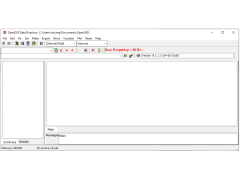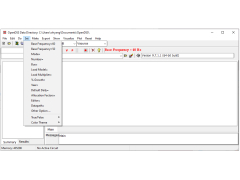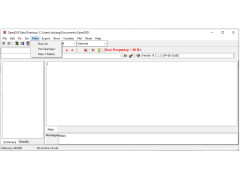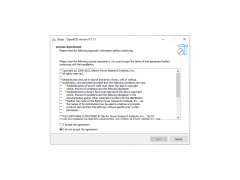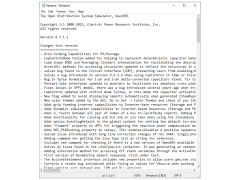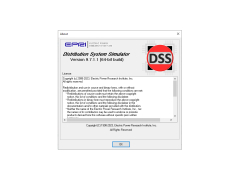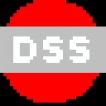
OpenDSS
by Tom McDermott
OpenDSS is an open-source software suite for modeling and simulating electrical power systems.
OpenDSS is an open source software package used to model electrical power distribution systems. It is developed and maintained by the OpenDSS team, an open source community of researchers, academics, and professionals. OpenDSS is available for free download and can be used to simulate and analyze the behavior of electrical power distribution systems.
OpenDSS is a comprehensive and powerful tool for electrical system analysis. It is capable of simulating a variety of electrical power distribution system components, including overhead lines, underground cables, transformers, and other electrical system components. It is also equipped with powerful features for analyzing the behavior of power system components, such as voltage drop, power flow, and fault studies.
OpenDSS is designed for use by electrical engineers, power system operators, and other professionals who need to design, analyze, and optimize power distribution systems. The software is written in the Delphi programming language and provides a flexible and user-friendly interface. OpenDSS also includes a comprehensive set of documentation and a detailed help system.
• Comprehensive Modeling: OpenDSS is capable of simulating a wide range of electrical power distribution system elements, including overhead lines, underground cables, transformers, and other components.
• Powerful Analysis Tools: OpenDSS includes powerful tools for analyzing the behavior of power system components, such as voltage drop, power flow, and fault studies.
• Flexible and User-Friendly Interface: The software is written in the Delphi programming language and provides a flexible and user-friendly interface.
• Comprehensive Documentation: OpenDSS includes a comprehensive set of documentation and a detailed help system.
• Open Source: OpenDSS is an open source software package and is available for free download.
• Simulation Platforms: OpenDSS is supported by a variety of simulation platforms, including MATLAB, Scilab, and others.
• Data Exchange: OpenDSS supports data exchange with other software packages, such as DigSILENT, CYME, and EasyPower.
• Customization: OpenDSS provides users with the flexibility to customize the simulation and analysis to fit their specific needs.
• Multi-user Environment: OpenDSS is designed to support multiple users working on the same project.
OpenDSS is a comprehensive and powerful tool for electrical system analysis. It is capable of simulating a variety of electrical power distribution system components, including overhead lines, underground cables, transformers, and other electrical system components. It is also equipped with powerful features for analyzing the behavior of power system components, such as voltage drop, power flow, and fault studies.
OpenDSS is designed for use by electrical engineers, power system operators, and other professionals who need to design, analyze, and optimize power distribution systems. The software is written in the Delphi programming language and provides a flexible and user-friendly interface. OpenDSS also includes a comprehensive set of documentation and a detailed help system.
OpenDSS allows users to efficiently simulate power systems and analyze power flow, thereby helping them make more informed decisions.Features:
• Comprehensive Modeling: OpenDSS is capable of simulating a wide range of electrical power distribution system elements, including overhead lines, underground cables, transformers, and other components.
• Powerful Analysis Tools: OpenDSS includes powerful tools for analyzing the behavior of power system components, such as voltage drop, power flow, and fault studies.
• Flexible and User-Friendly Interface: The software is written in the Delphi programming language and provides a flexible and user-friendly interface.
• Comprehensive Documentation: OpenDSS includes a comprehensive set of documentation and a detailed help system.
• Open Source: OpenDSS is an open source software package and is available for free download.
• Simulation Platforms: OpenDSS is supported by a variety of simulation platforms, including MATLAB, Scilab, and others.
• Data Exchange: OpenDSS supports data exchange with other software packages, such as DigSILENT, CYME, and EasyPower.
• Customization: OpenDSS provides users with the flexibility to customize the simulation and analysis to fit their specific needs.
• Multi-user Environment: OpenDSS is designed to support multiple users working on the same project.
OpenDSS is a software package designed to simulate large electrical power systems. It is a Windows-based program written in the Delphi programming language. It requires Windows 7 or higher, as well as a CPU running at least 2GHz, 4GB of RAM, and 1GB of free hard drive space. Additionally, it requires an Internet connection for downloading updates and accessing online help.
PROS
Handles complex analysis tasks efficiently, saves time.
Highly versatile for power system simulations.
Free, open-source with a supportive community.
Highly versatile for power system simulations.
Free, open-source with a supportive community.
CONS
Steep learning curve for beginners in electrical engineering software.
Limited graphical user interface capabilities.
Limited technical support and documentation available.
Limited graphical user interface capabilities.
Limited technical support and documentation available.
Hamish X******f
OpenDSS is a great tool for electrical engineers. It's user friendly, fast and intuitive. I especially appreciate the wide range of features it offers. It's very convenient to be able to model different scenarios and see the results quickly. I also like the fact that it is free and open source software. It's a great way for students or anyone with limited resources to learn about power systems. The documentation provided is also very helpful. Overall, OpenDSS is a powerful and reliable tool.
Fraser I.
OpenDSS is a great tool for electrical engineers, it's user friendly and offers a lot of flexibility when running simulations - though I have had some issue's with its accuracy.
Cole S.
This software is a powerful electrical simulation tool that allows users to model and analyze electric power distribution systems. It includes a wide range of features such as load flow analysis, fault analysis, and transient analysis, as well as support for a variety of different power system components such as generators, transformers, and capacitors. Other key features of the software include the ability to create and simulate complex electrical networks, as well as the ability to generate detailed reports and visualizations of simulation results. Overall, this software is a valuable tool for engineers and researchers working in the field of electrical power systems.
Cameron Hassenzahl
The software provides a variety of tools to analyze and simulate power systems.
Finlay
Intuitive interface, highly customizable, robust power flow analysis.
Benjamin
Versatile, complex, informative, robust, user-friendly.
